| HOME |
|---|

| HOME |
|---|

To the Greeks he was Cronus (Kronus), the god of time (giving us the prefix chron, or chrono, for time). He was one of the first gods, the Titans, born from the union of Mother Earth (Gaia,) and Father Sky (Uranus). He was the father of Zeus (Jupiter,) who went on to become king of the gods. The Romans renamed him Saturn, and he was arguably their most important god. They made him the god of agriculture, and named the sixth planet from the Sun after him, as well as the sixth day of the week. The Romans also instituted the festival of Saturnalia, a week long celebration in honor of the god Saturn, in which everyone was - temporarily - considered as equals, slaves and senators alike, and gifts were exchanged. The week long festival began on December 17, and over the centuries evolved into the modern celebration of Christmas.

Nobody forgets the first time they see Saturn and its rings through a telescope. It is truly a breathtaking sight. The other three gas giants in the outer solar system also have ring systems, but they are faint and hard to see. Nothing compares to the awe inspiring splendor of the rings of Saturn, and the magic of seeing them firsthand.
Just slightly smaller than Jupiter, with a diameter of 75,000 miles (120,000 km), Saturn is the second largest planet in the solar system, sixth in line from the Sun, and second of the gas giants that reside in the outer solar system, beyond the Asteroid Belt.
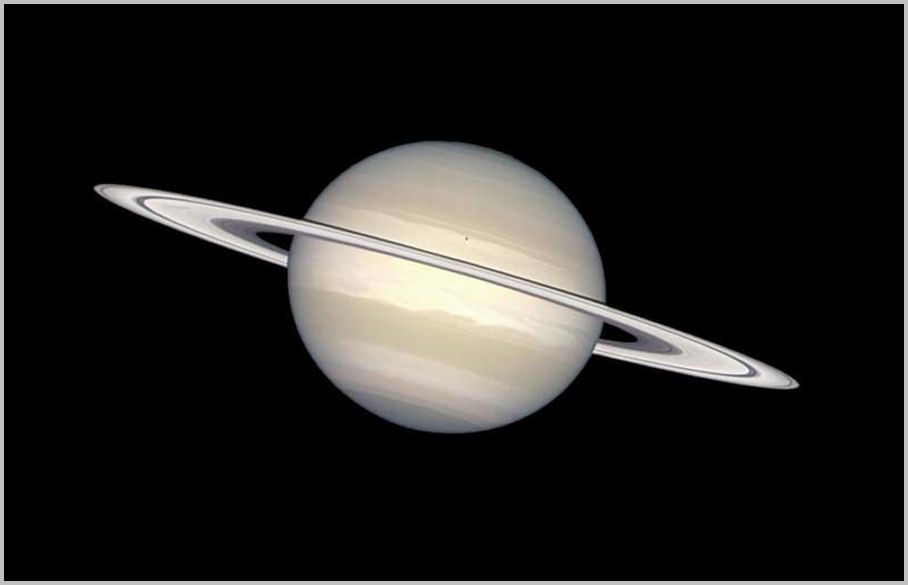
Saturn is 892 million miles (1,427 million km) from the Sun, almost twice as far from the Sun as Jupiter, and almost ten times as far from the Sun as Earth. It is the last planet that can be discerned as such through a backyard telescope. The rest of the planets beyond Saturn are only star-like points of light in all but the largest telescopes.
Like Jupiter, Saturn spins incredibly fast for its huge size. One day on Saturn lasts only 10.2 hours. Its year on the other hand, lasts almost 30 Earth years.
Saturn's glory, of course, is its magnificent ring system. Although they appear solid, the rings are actually composed of countless chunks of dirty ice, ranging in size from microscopic to kilometer sized. The rings begin 4,200 miles (6,700 km) above Saturn's clouds, and extend all the way out to a distance of 300,000 miles (480,000 km). They are so thin - only a few hundred feet in most places - that seen edge on they are almost invisible.
In September, 2006, NASA's Cassini spacecraft slipped behind the planet and into its shadow, capturing Saturn's rings, backlit by the Sun, as never seen before. As an unexpected bonus, through a gap in the rings, Cassini's camera also captured the pale blue dot of Earth, almost a billion miles away.
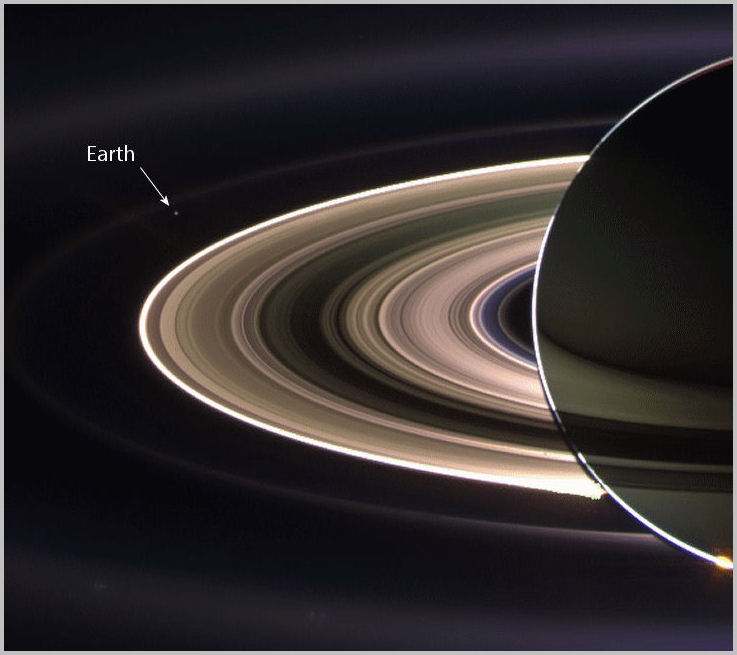
Saturn has no less than 53 known moons. The largest, and most interesting is Titan. Titan has a diameter of 3,218 miles (5,149 km), making it larger than the planet Mercury, and if conditions are just right, you can see it in a backyard telescope as a pinprick of light off to the side of Saturn. Titan orbits quite far from Saturn, out at a distance of 759,000 miles (1,222,000 km). It also has a thick atmosphere, the only object in the solar system other than Earth and Venus to do so, prompting much speculation as to the real possibility of it harboring some form of life beneath its clouds. But like Venus, the clouds of Titan keep its surface completely hidden from us. The photo below, of the permanently cloud shrouded Titan, was taken by NASA's Cassini Spacecraft.
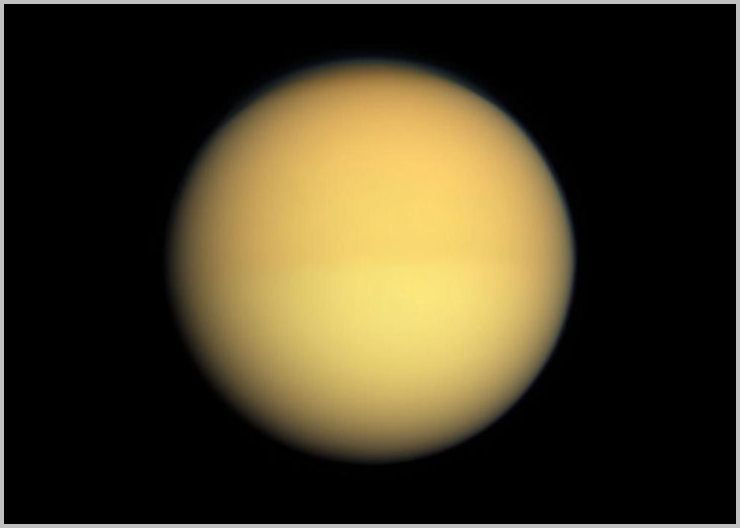
On Christmas Day, 2004, far out in the icy, inky depths of the outer solar system, a billion miles from Earth, two spacecraft completed their seven year journey together to the planet Saturn, and parted company. The larger craft, NASA's Cassini orbiter, went into orbit around Saturn to begin a three year mission gathering data and photos.
The smaller craft, the European Space Agency's planetary probe named Huygens, headed for Saturn's moon, Titan. Twenty days later, on January 14, 2005, it arrived. Firing reverse thrusters, the probe decelerated from over 11,000 mph (18,000 kph) down to 875 mph (1,400 kph). As it entered Titan's atmosphere, a series of parachutes slowed it finally to 13 mph (20 kph). Huygens broke through Titan's clouds at an altitude of 19 miles (30 kms), and took the overlapping greyscale photos below of its landing site. They clearly show hills and cliffs, with liquid carved channels flowing down to the shore of a wide riverbed. Since it is far too cold, -173 ° C, (-290 ° F ) for water to exist in a liquid form, these features are most likely formed by liquid methane.
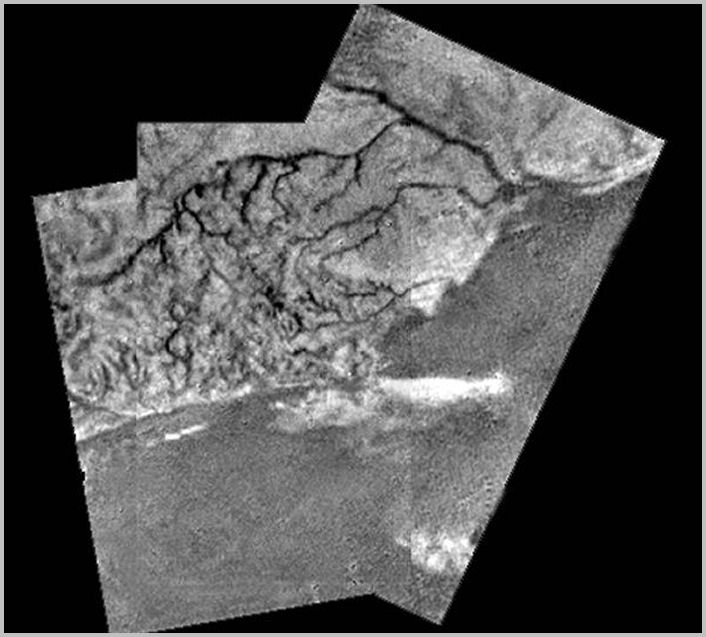
As a testament to skills of the scientists involved, Huygens survived the hard landing, and for the next 72 minutes transmitted reams of data back to Earth, enough to keep scientists busy for years, including the first ever photo of the surface of Titan, shown below. The rocky surface, bathed in a ruddy glow from the refraction of the clouds, is eerily similar to Mars, and the rounded, eroded appearance of the rocks seems to confirm the presence of liquids. History had just been made. Titan became the most distance world touched by human technology.
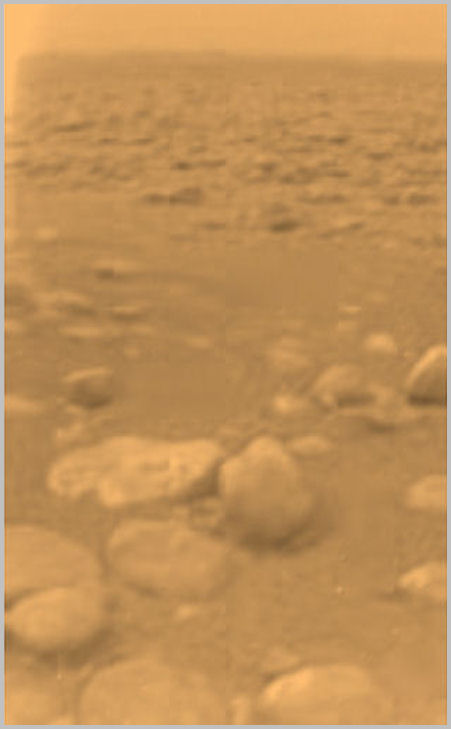
Saturn's next largest moon is Rhea, named for the sister of Cronus (Saturn), who became his wife, and bore him many offspring. With a diameter of 949 miles (1,528 km), it is only a fraction - less than a third - the size of Titan, and orbits very much closer to the giant planet, only 327,000 miles(527,000 km) away. The moon's heavily cratered surface indicates a lack of any recent geological activity.
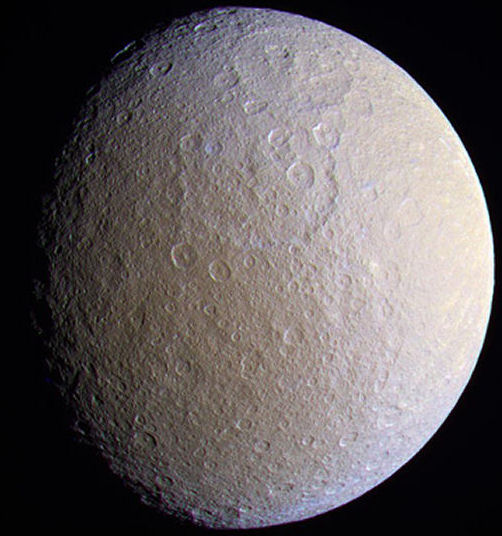
With a diameter of 914 miles (1,471 km), the third largest moon of Saturn is Iapetus (eye-APP-eh-tuss), named for a brother of Cronus (Saturn). It is strikingly unusual in that half the moon is black and half the moon is white, giving rise to the nickname the yin yang moon. Iapetus orbits at the extreme distance of 2,213,000 miles (3,561,000 km), making it the most distant of the large Saturn moons. It appears to be geologically inactive.
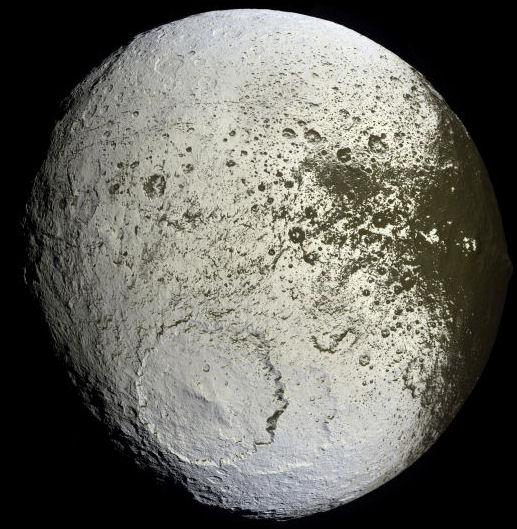
With a diameter of 702 miles (1,123 km), Dione (die-OH-nee) is the fourth largest moon of Saturn, named for a sister of Cronus (Saturn). It orbits at a distance of 235,872 miles (377,396 km).
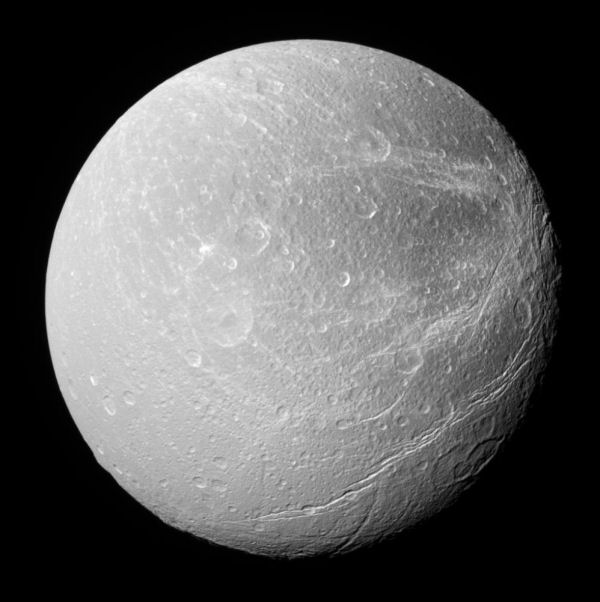
Slightly smaller, with a diameter of 664 miles (1,062 km), Tethys (TEE-thus) is the last of the five largest moons of Saturn, named for another of the Titan siblings of Cronus (Saturn). It orbits at a distance of 184,137 miles (294,619 km).
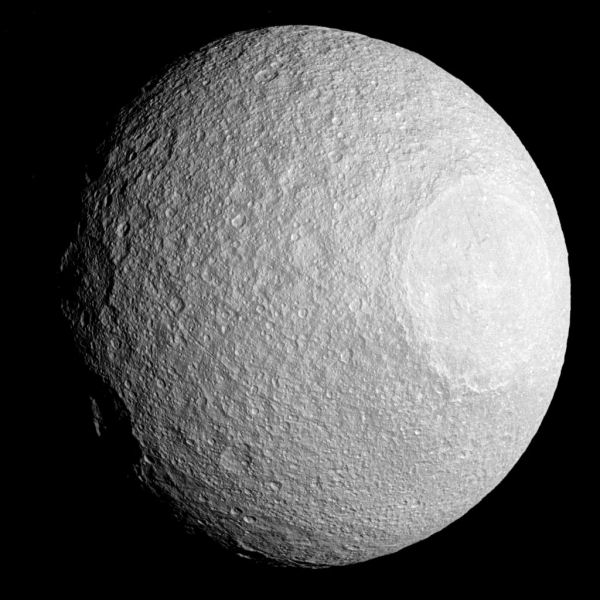
In March, 2006, the Cassini Spacecraft found something dramatic. It found evidence of liquid water, almost a billion miles from the Sun, where it is far too cold for liquid water to exist. The water was found on Saturn's moon, Enceladus (another brother of Cronus), erupting from the moon's surface in ice crystal geysers extending 300 miles out into space. Since the surface of Enceladus is a chilly -330 degrees F (-201 degrees C), it can only mean that heat is being produced in the interior of the moon. Since Enceladus orbits very close to Saturn, only 148,000 miles (238,000 km), it is quite possible that the tidal forces of Saturn's gravity are creating enough internal heat in the moon to melt any water ice below the surface. Of course the significance of all this is that wherever there is liquid water, there is at least the possibility of some kind of life evolving. The Cassini image below, captures some of these water ice geysers, backlit by the Sun. With a diameter of only 300 miles (500 km), Enceladus is the sixth largest moon of Saturn.
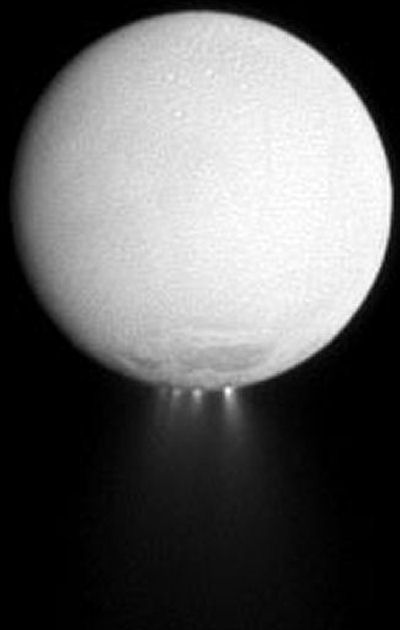
|
|
|
| SOL | MERCURY | VENUS | EARTH | METEORS | MOON | MARS | ASTEROIDS | JUPITER | SATURN | URANUS | NEPTUNE | PLUTO | COMETS |
|
|
|